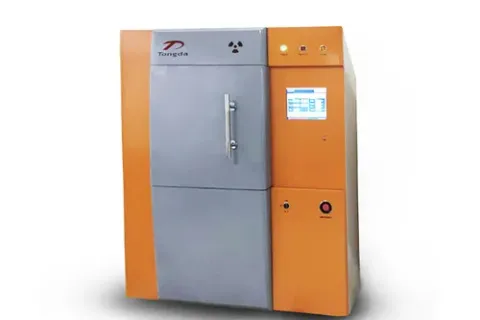
- Home
- >
News
In research fields such as life sciences, radiation biology, and pest control technology, precise, safe, and controllable irradiation methods are fundamental to many critical experiments. Leveraging its expertise in X-ray technology, Dandong Tongda Technology Co., Ltd. has developed the WBK-01 X-ray Irradiator, designed to provide a modern alternative to traditional radioactive isotope sources for various laboratories. I. Core Principle and Design Purpose The equipment operates by accelerating electrons through a high-voltage electric field to strike a metal target (e.g., a gold target), thereby generating high-energy X-rays. This design of an "electrically generated radiation source" fundamentally avoids the use of radioactive isotopes like Cobalt-60 (Co-60) or Cesium-137 (Cs-137), eliminating the long-term custody, substantial decommissioning costs, and potential safety hazards associated with source materials. II. Core Product Features High Safety: No Radiation When Powered Off: X-rays are only generated when the equipment is powered on and operating. There is no residual radiation after operation, significantly reducing laboratory security and management costs. Multiple Safety Interlocks: Equipped with multiple safety protection features including door-operation interlock, emergency stop, and overdose protection, ensuring the safety of operators and the environment. Precise Control and Good Reproducibility: Utilizes a digital control system, allowing users to precisely set irradiation parameters—including voltage (kV), current (mA), and irradiation time—via a touchscreen interface. The system enables stable dose output, ensuring uniformity in experimental conditions and reproducibility of results. Easy Operation and Simple Maintenance: The user interface is simple and intuitive, easy to learn and operate, lowering the barrier to use. Compared to isotope sources which require regular replacement and decay monitoring, the main maintenance for this equipment focuses on the periodic replacement of the X-ray tube, resulting in relatively fixed and manageable long-term maintenance costs. Flexible Sample Compatibility: The irradiation chamber is designed to accommodate various samples, from cell culture dishes and multi-well plates to small animals (e.g., fruit flies, mosquitoes, or mice). The sample stage can be designed to rotate, ensuring uniformity in radiation dose distribution. III. Main Application Scenarios Biomedical Research: Used for creating immunodeficient animal models (e.g., ablating bone marrow cells in mice), inducing cell apoptosis, synchronizing cell cycles, oncology research, and pre-treatment for stem cell transplantation. Sterile Insect Technique (SIT): This is a significant application area. It can be used to irradiate pupae of agricultural pests (e.g., Mediterranean fruit fly) or mosquitoes to render them sterile, thereby supporting green, pollution-free population control programs. Material Modification Research: Can be used to study the effects of X-rays on the properties of various materials (e.g., polymers, semiconductors). IV. Typical Model Parameters (Using WBK-01 as an example) X-ray Tube Voltage: Adjustable based on requirements, typically within a range from several tens to hundreds of kilovolts (kV), to suit different penetration depths and dose rate needs. Dose Rate: Can be adjusted based on voltage, current, and distance to meet the specific requirements of different experimental protocols. Uniformity: Ensured through optical system design and a sample rotation mechanism, guaranteeing uniform dose distribution within the irradiation field for reliable experiments. Summary The core value of the Dandong Tongda X-ray Irradiator lies in its replacement of inconvenient radioactive isotope sources with a safe, controllable, electrically generated X-ray source. It does not pursue excessive features but focuses on providing a stable, reliable, compliant, and easy-to-manage irradiation tool for scientific research and industrial applications. For laboratories seeking alternatives to isotopes or planning to establish new irradiation platforms, this is a practical piece of equipment worthy of evaluation and consideration by users in basic research and applied fields.
The WBK-01 X-ray irradiator generates high-energy X-rays to irradiate cells or small animals. X-ray irradiator is used for various basic and applied research. Throughout history, radioactive isotope irradiators have been used, which require transporting samples to a core irradiation facility. Today, smaller, safer, simpler, and lower cost X-ray irradiator can be installed in laboratories for convenient and rapid irradiation of cells. Various samples can be directly irradiated in the laboratory without affecting fertility or safety. The X-ray irradiator is easy to use for personnel without professional X-ray training, and there are no expensive license applications or safety or radiation source maintenance costs. This device is easy to operate, safe, reliable, and cost-effective, and can replace radioactive isotope sources. 1. Principle of X-ray irradiator: The X-ray tube in the X-ray irradiator generates high-energy electrons, which produce X-rays when they collide with the target material (usually tungsten). Accelerating electrons through a high-voltage electric field to obtain sufficient energy to generate the required X-ray wavelength and intensity. Then, the X-rays are adjusted and optimized through a series of collimators, filters, and other devices, and finally irradiated onto the sample. The main components of an X-ray irradiator are: The X-ray irradiator mainly includes X-ray tubes, high-voltage generators, control circuits, cooling systems, safety protection devices, and sample rooms. Among them, the X-ray tube is the core component responsible for generating X-rays; The high-voltage generator provides the required high voltage and current for the X-ray tube; The control circuit is used to control parameters such as the generation, intensity, and irradiation time of X-rays; The cooling system ensures that the equipment will not be damaged due to overheating during operation; The safety protection device ensures the safety of operators and the usage environment. 3. Application areas of X-ray irradiator: The X-ray irradiator can be used in the field of biology: it can be used for cell culture and division inhibition research, gene change induction, stem cell research, small animal irradiation, T-B cell research, blood cell research, bone marrow transplantation irradiation, transplantation immunity, immunosuppressive therapy, radiation sensitivity research, DNA damage research, etc. The X-ray irradiator can be used in the medical field: in tumor treatment, it can be used to locally irradiate the tumor site, kill cancer cells or inhibit their growth; The X-ray irradiator can also be used as an auxiliary diagnosis for certain diseases, such as helping to determine the condition by observing the imaging changes of tissues and organs through X-rays. The X-ray irradiator can be used in the food industry: it can be used for food irradiation preservation, killing microorganisms in food through X-ray irradiation, inhibiting enzyme activity, thereby extending the shelf life of food while maintaining its original taste and nutritional content. The X-ray irradiator can be used in the industrial field: it can be used for material performance testing and modification, such as cross-linking treatment of polymer materials to improve their strength and stability; It can also be used for non-destructive testing to detect defects and cracks inside materials. In summary, X-ray irradiator is an important scientific and industrial device with broad application prospects and value.
The X-ray irradiator generates high-energy X-rays to irradiate target objects or biological tissues. The generation of X-rays is usually achieved by accelerating electrons to collide with metal targets (such as tungsten, copper, etc.), generating bremsstrahlung and forming X-ray beams, which then irradiate cells or small animals. X-ray irradiator is used for various basic and applied research. Historically, radioactive isotope irradiators were used, which required transporting samples to a core irradiation facility. However, today, smaller, safer, simpler, and lower cost X-ray irradiator can be installed in laboratories for convenient and rapid irradiation of cells. Various samples can be directly irradiated in the laboratory without affecting fertility or safety. The X-ray irradiator is convenient for personnel who have not received professional X-ray training to use, and there are no expensive license applications or safety or radiation source maintenance costs. The X-ray irradiator is easy to operate, safe, reliable, and cost-effective, and can replace radioactive isotope sources. 1. The main application areas of X-ray irradiator include medical field, scientific research field, etc 2. Safety precautions for X-ray irradiation equipment: Radiation protection: Operators need to wear protective clothing to avoid prolonged exposure to X-rays. Equipment maintenance: Regularly inspect the equipment to ensure its normal operation and prevent radiation leakage. Dose control: Strictly control the irradiation dose to avoid unnecessary harm to the sample or human body.
The X-ray irradiator can generate high-energy X-rays to irradiate cells or small animals. Used for various basic and applied research. Throughout history, radioactive isotope irradiators have been used, which require transporting samples to a core irradiation facility. Today, smaller, safer, simpler, and lower cost X-ray irradiation equipment can be installed in laboratories for convenient and rapid irradiation of cells.
Cabinet X-ray irradiator is used to irradiate cells or small animals. An X-ray irradiator is an instrument that uses high-energy X-rays to irradiate substances in order to achieve specific biological or physical effects. Used for various basic and applied research. Throughout history, radioactive isotope irradiators have been used, which require transporting samples to a core irradiation facility. Today, smaller, safer, simpler, and lower cost X-ray irradiation equipmentcan be installed in laboratories for convenient and rapid irradiation of cells. Modern X-ray irradiation equipment is equipped with comprehensive safety protection measures, such as emergency stop devices, over temperature protection, automatic preheating functions, etc., to ensure safe operation.
The cabinet X-ray irradiator system generates high-energy X-rays to irradiate cells or small animals. Used for various basic and applied research. In history, radioactive isotope irradiator equipment has been used, which requires transporting samples to a core irradiation facility. Today, smaller, safer, simpler, and lower cost X-ray irradiator devices can be installed in laboratories for convenient and rapid irradiator of cells. Various samples can be directly irradiated in the laboratory without affecting fertility or safety. This biological X-ray irradiator device is convenient for personnel without professional X-ray training to use, and there are no expensive license applications or maintenance costs for safety or radiation sources. The X-ray irradiator instrument is easy to operate, safe, reliable, and cost-effective, and can replace radioactive isotope sources.
Recently, the Ministry of Science and Technology announced the list of the second batch of key projects under the 2023 National key research and Development Plan "Basic scientific research Conditions and major scientific instruments and equipment research and development".
Biological X-ray irradiator irradiates organisms with high-energy rays with ionizing radiation effect within a predetermined time, producing biological effects or suffering irreversible damage and destruction to achieve biological purposes.
Micro-ct technology has significant advantages in the characterization of ceramics, which can reveal the composite structure inside the material without damage, and restore the key technology in the production of ceramics.
Binder is a polymer compound used in electrode making to adhere the active substance to the collector fluid. The main function is to bond and maintain active substances.










